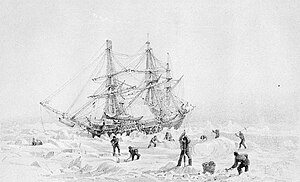 HMS Terror in the Arctic
| |
| History | |
|---|---|
| Name | Terror |
| Ordered | 30 March 1812 |
| Builder | Robert Davy, Topsham, Devon |
| Laid down | September 1812 |
| Launched | 29 June 1813 |
| Completed | By 31 July 1813 |
| Fate | Abandoned 22 April 1848, King William Island |
| Wreck discovered | 3 September 2016, Terror Bay |
| General characteristics | |
| Class and type | Vesuvius-class bomb vessel |
| Tons burthen | 325 (bm) |
| Length | 102 ft (31 m) |
| Beam | 27 ft (8.2 m) |
| Installed power | 30 Nominal horsepower[1] |
| Propulsion | |
| Complement | 67 |
| Armament |
|
| Official name | Wrecks of HMS Erebus and HMS Terror National Historic Site |
| Designated | 2019 |
HMS Terror was a specialised warship and a newly developed bomb vessel constructed for the Royal Navy in 1813. She participated in several battles of the War of 1812, including the Battle of Baltimore with the bombardment of Fort McHenry (as mentioned in The Star-Spangled Banner: "And the Rockets' red glare, the Bombs bursting in air"). She was converted into a polar exploration ship two decades later, and participated in George Back's Arctic expedition of 1836–1837, the successful Ross expedition to the Antarctic of 1839 to 1843, and Sir John Franklin's ill-fated attempt to force the Northwest Passage in 1845, during which she was lost with all hands along with HMS Erebus.
On 12 September 2016, the Arctic Research Foundation announced that the wreck of Terror had been found in Nunavut's Terror Bay, off the southwest coast of King William Island. The wreck was discovered 92 km (57 mi) south of the location where the ship was reported abandoned, and some 50 km (31 mi) from the wreck of HMS Erebus, discovered in September 2014.
- ^ Bourne, John (1852). "Appendix, Table I: Dimensions Of Screw Steam Vessels In Her Majesty's Navy". A treatise on the screw propeller: with various suggestions of improvement. London: Longman, Brown, Green, and Longmans. p. i.